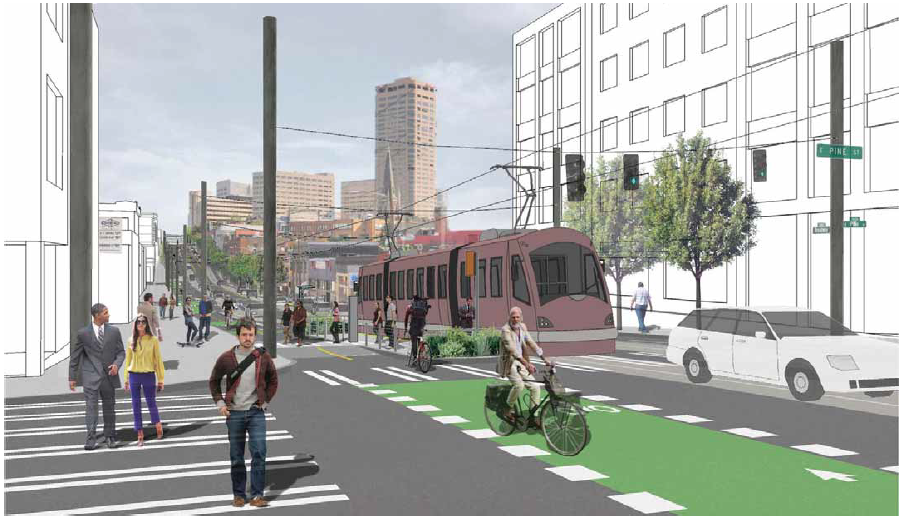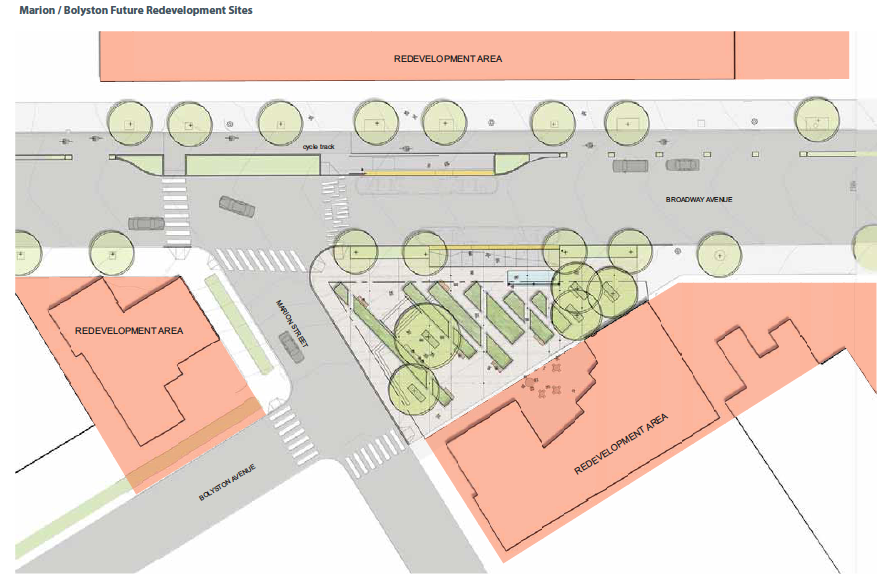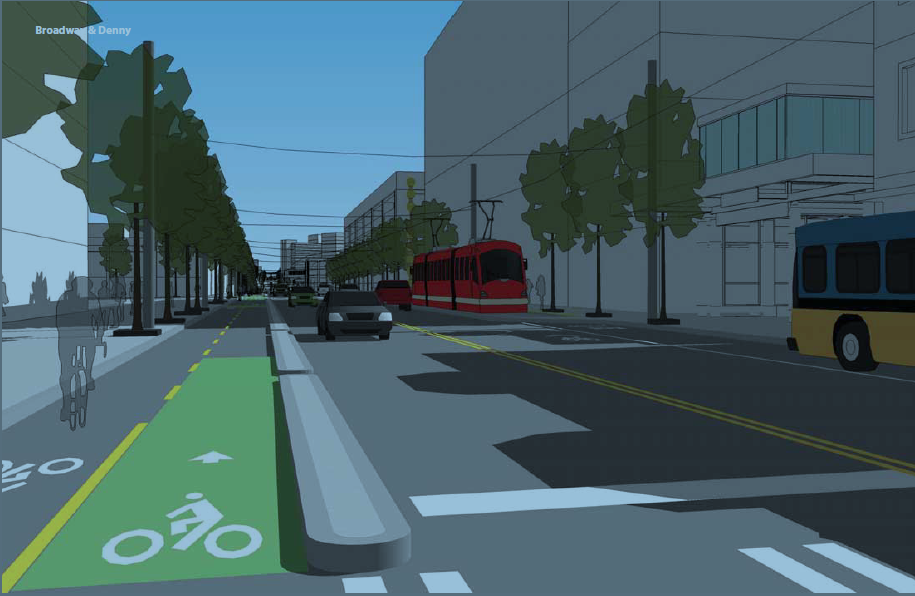With construction expected to begin early in the New Year, Seattle streetcar planners and designers went before the city’s Design Commission last week to present the latest plans for the First Hill streetcar route that will run between the International District and Capitol Hill by the end of 2013.
 Broadway at Pine circa 2014 (Image: SDOT/Mithun)
Broadway at Pine circa 2014 (Image: SDOT/Mithun)
The designs from the presentation, embedded below, flesh out features like the cycle track “art bollards” that will be used to separate bike traffic from car and train traffic along some sections of the route including Broadway. It also diagrams the plan for a new Marion/Boylston plaza along the route.
Construction on the $132 million project is expected to begin in January with work beginning on First Hill between Madison and Boren. Work on Capitol Hill would start later around mid-year. SDOT says a detailed construction schedule should be available in December.
Money to complete the currently planned project is locked in and the streetcar line’s alignment is finalized but there is continued interest from the community in extending the line north on Broadway to Roy instead of the currently planned terminus near Broadway and Denny, the future home of the light rail station. The city won a $900,000 grant to study connecting the South Lake Union and First Hill streetcar lines but a ballot measure that would have funded several transit projects with increases in car licensing fees was defeated in this month’s election. How things shake out for any extension of the First Hill line remains to be seen.






idea #1 Why spend $900,000 to realize there is already a rail link to the two streetcar lines, the light rail tunnel connects them?
idea #2 Why put Jackson street on such a traffic diet with one lane Eastbound for cars, bikes, and streetcars?
idea #3 Why not stop at 5th Ave. and move over to King street, where there is less traffic, and use the 5th to 2nd Ave funds to continue north to Aloha street?
idea #4 There could be a 12th Ave turn north from King Street to Yesler (not going out to 14th Ave) and avoid the 14th and Boren overhead wire turn.
Jackson is already a transit corridor, the ridership is already there. Having the streetcar stop short of Pioneer Square essentially at a dead-end (5th & King) would hurt its ability to expand in the future.
I do agree with the 12th vs. 14th Avenue comment, but perhaps it’s to connect the higher-density neighborhood near 14th & S. Main with the I.D. and Yesler Terrace / First Hill. The ridership is already there, as well.
Jackson needs to be re-constructed. It doesn’t need four to five lanes of automobile traffic, and this option will improve safety in the area.
Has the city stated how much money would be required to extend the line to Aloha?
Gordon,
A lot. Between $21 million and $24 million.
It’s not funded by the ST2 ballot measure, so funding would have to be secured sometime in the future.
Source: http://www.soundtransit.org/Documents/pdf/st2/st2_final/N07c
It looks like the street is going to have a narrow bicycle path on one side of the street, and one lane of traffic on the other in places? What a mess. One or the other people! Where do the cyclists going the other direction go? Ditch the other lane of traffic and make it have useful bike lanes. The remaining lane of traffic is going to be useless anyway.
(Also is in too small a font to read and no way to zoom in – boo!)
When will people learn…
The bike lanes are two-way (see design of Broadway and Denny above)
The presentation in Scribd (also above) is where those pictures are from, and is fully zoom-able.
Any chance one of folks reading this may be able to point me to a map of what the cycletrack route is, so I can start planning my 2013 home purchase? ;-)
(I’ve looked all over and haven’t been able to find it ;-(.
It’s the absence. It must be filled. People just can’t handle Broadway [blank] E.
12th Ave has a big water main under it, so I know avoiding that was one of the factors.
I am so ready to ride! This and light rail! The waiting is killing me!!!
You can tell how excited I am by all the exclamation points!!!!!!!!!!!!!!!!!!!!!!!!!!!!!!!!!!!!!!!!!111one
At this point I think the cycle track will only extend along the current streetcar route on Broadway (Yesler in the South to Denny in the North). Page 42 shows how the cycle track will meld into standard bike lanes at Yesler. I didn’t see anything on how they will deal with it at Denny.
As this thing gets built I think the next advocacy opportunity will be extending the cycle track to connect with other bike amenities. Northboud it shouldn’t be too expensive (knock on wood) to continue the cycle track down 10th to Roanoke, where one could connect to Interlaken and the Burke-Gilman pretty comfortably. South a little more infrastructure could get bikers easily across the Jose Rizal Bridge and connect with the I-90 trail.
This connection would truly be amazing. It would mean that all of the cyclists in the central part of the city (CD/CH) who aren’t as comfortable riding in vehicle traffic could use this cycle track to access literally dozens of miles of bike paths throughout the region.
Thank you, Josh!
I hope that the trees along Broadway aren’t removed. They soften up the look of the street, especially re: all of the new apts. with no set-backs from the street.
I agree. There is not enough of a commitment in Seattle to preserve healthy street trees. I hope citizens will contact the City Arborist’s office to express concern whenever/wherever they see trees threatened by unjustified removal, or where homeowners remove trees from their parking strip without a permit.
Such action can actually work. At the 230 Broadway development, the trees on the Broadway side were marked for removal. The City Arborist received a number of complaints, he reconsidered the decision, and now those trees will remain in place.
“There is not enough of a commitment in Seattle to preserve healthy street trees.”
Are you kidding? This city has more trees than any other city I’ve ever been to! Everytime there is construction they cordon off all the trees. I also feel like trees are prioritized over pedestrians – note the huge sidewalk cutouts on Pine St. – there’s about a foot and a half of sidewalk and the rest is for the trees.
The drawings don’t show all the overhead wires. It is true that the streetcar itself will only need wire in one direction, since it will return to the I.D. on battery power. However it travels alongside trolleybus routes which have a total of 4 strands of overhead wire of their own, along Broadway and along Jackson. I personally love the web of wires over Broadway so I notice it when they are Photoshopped out of photographs or omitted in drawings such as these.
Where are you getting your information? My understanding is the streetcar will only be on batteries near the terminals, to avoid trolley special work.
$132 million for this?
Do they have ANY idea how many buses this could pay for? Even at $750,000 per bus, that is 176 buses. Even if you sent each bus through the route only once a day, you would be getting a fresh bus through this route every 8 minutes and 18 seconds 24 hours a day. Buses are not locked into a track in the road either. What makes a “streetcar” better than a bus which can go anywhere and does not require all this infrastructure for it? Insanity.
Well, then, you must have lived in some pretty barren cities. In my opinion, a city cannot have enough trees.
Seattle has lost something like 30% of its total “tree canopy” in the past few decades….that is a fact. It’s time to stop that trend.
It was in one of the press releases about the manufacturing of the rolling stock for this line, touting the off wire capability of the vehicles, stating that the vehicles would use line power from The I.D. to Capitol Hill, and power from batteries and regenerative braking on the return trip. Seems to me the cars should also retract their pantograph while traversing the web of special work at Boren/Jackson and Broadway/Madison since it would be a huge topological challenge to run a streetcar wire through those areas.
This belongs in the same drawer as Capital Hill. And the Olive Way/Olive Street debacle. And the double Broadway QFCs. I’m just glad that Broad Street is nowhere near the Hill.
We voted on it, and this is what we wanted. As they say over at the occupation, This is what Democracy looks like.
Besides, buses are gross.
Your points aren’t without merit, but there are reasons for choosing a streetcar over buses.
They’ve been shown to attract riders that buses fail to, and people are more likely to just hop on a streetcar when it’s on tracks. Maybe just because they can see where it’s gonna go for some distance, I’m not sure. They also tend to be nicer to ride in (more comfortable, clean, etc.).
It’s also a much more permanent piece of transportation infrastructure, and I suspect it encourages development in a way that buses can’t compete with. If you’re a developer looking to build new residential units with low parking ratios, you want to know that there is always going to be transit nearby to draw in residents. Buses do a decent job of that, but bus routes can move or get eliminated. Streetcar lines tend to be more permanent (early Seattle streetcar/trolley lines notwithstanding).
Citizen Rail, it is not accurate to say that this streetcar line was put up to a vote of the people. It is being financed by Sound Transit as mitigation for their decision not to put in a light rail stop on First Hill.
That said, I think the streetcar will be a great addition to our city, just as the one in Lake Union has become
It would buy about half of the planned/built rapidride lines. That’s not that much bus service. The real waste of money is in highway projects (tunnel, mercer, spokane st.) When the number of cars on Seattle streets are going down.
Besides, Portland has shown that streetcars always bring more money in in terms of business activity and developement than the cost to build them.
Calhoun, that Sound Transit package was voted on in November of 2008 and passed easily. It clearly included the First Hill Streetcar in the list of projects to be funded by that .9% sales tax increase. So yes, it was voted on by the people.
ST and the City of Seattle should pressure their legislative delegation to request a Sales Tax Deferral (~10% tax) on a $100+ million project will generate about half the amount.
The remainder could be picked up with LID (Local Improvement District Assessment) that the businesses and residents who will benefit will pay. Maybe even a graduated assessment so that those who seemingly get less value (e.g., those in Chinatown and Pioneer Square) would pay less since they benefit less from the extension–but they still benefit from having a more user-friendly system.